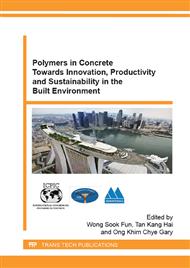p.523
p.530
p.538
p.546
p.557
p.565
p.573
p.581
p.586
Restoration of Historic Concrete Structures with Modern Materials - A Case Study
Abstract:
Today the requirements for concrete restoration are not only aspects of retrofitting or restoration of bearing capacity but increasingly aspects of preservation of historic structures, such as industrial monuments, civil engineering structures and buildings of the 60s. The Polymer modified self-compacting concrete (PSCC) is a suitable material to be applied in this field, as it not only has excellent mechanical properties (e.g. high bond strength, low Young's modulus) but it is also possible to imitate colours and textures similar to those of the original surfaces. PSCC is therefore an interesting alternative to well established materials, such as PCC, sprayable PCC (SPCC) and shotcrete.Presented in this paper are the results of the further development of PSCC for a particular scenario where due to limited accessibility, the application method and therefore the mix design had to be optimised. Characteristic fresh and hardened concrete properties were investigated and special attention was given to deviation of the fresh concrete with regard to variations in the amounts of source materials.It is shown that although PSCC is a high-performance material, dosage of its source materials, mixing and application of the material itself can be done with simple conventional building site equipment. At the same time a robust fresh concrete as well as excellent surface properties of the hardened concrete can be obtained. Purpose-made mix designs can be developed for various applications with excellent results in performance and appearance.
Info:
Periodical:
Pages:
557-564
Citation:
Online since:
November 2015
Authors:
Keywords:
Price:
Сopyright:
© 2015 Trans Tech Publications Ltd. All Rights Reserved
Share:
Citation:



